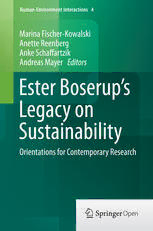
Ester Boserup’s Legacy on Sustainability: Orientations for Contemporary Research PDF
Preview Ester Boserup’s Legacy on Sustainability: Orientations for Contemporary Research
Ester Boserup’s Legacy on Sustainability Human-Environment Interactions VOLUME 4 SeriesEditor: ProfessorEmilioF.Moran, MichiganStateUniversity(Geography) EditorialBoard: BarbaraEntwisle, Univ.ofNorthCarolina(Sociology) DavidFoster, HarvardUniversity(Ecology) HelmutHaberl, KlagenfurtUniversity(Socio-ecologicalSystemScience) BillieLeeTurnerII, ArizonaStateUniversity(Geography) PeterH.Verburg, UniversityofAmsterdam(EnvironmentalSciences,Modeling) Forfurthervolumes: http://www.springer.com/series/8599 Marina Fischer-Kowalski (cid:129) Anette Reenberg Anke Schaffartzik (cid:129) Andreas Mayer Editors Ester Boserup’s Legacy on Sustainability Orientations for Contemporary Research 2123 Editors MarinaFischer-Kowalski AnkeSchaffartzik InstituteofSocialEcology InstituteofSocialEcology AlpenAdriaUniversity AlpenAdriaUniversity Vienna Vienna Austria Austria AnetteReenberg AndreasMayer Dept.Geosciences&ResourceMgmt InstituteofSocialEcology UniversityofCopenhagen AlpenAdriaUniversity KøbenhavnK Vienna Denmark Austria Chapter1isreprintedwithpermissionfromPNAS. B.L.TurnerIIandMarinaFischer-Kowalski. EsterBoserup:Aninterdisciplinaryvisionaryrelevantforsustainability. PNAS2010,Volume107,no.51,pp.21963–21965 ISBN978-94-017-8677-5 ISBN978-94-017-8678-2(eBook) DOI10.1007/978-94-017-8678-2 SpringerDordrechtHeidelbergNewYorkLondon LibraryofCongressControlNumber:2014931401 © The Editor(s)(if applicable) and theAuthor(s) 2014. The book is published with open access at SpringerLink.com OpenAccessThisbookisdistributedunderthetermsoftheCreativeCommonsAttributionNoncom- mercialLicensewhichpermitsanynoncommercialuse,distribution,andreproductioninanymedium, providedtheoriginalauthor(s)andsourcearecredited. AllcommercialrightsarereservedbythePublisher,whetherthewholeorpartofthematerialisconcerned, specificallytherightsoftranslation,reprinting,re-useofillustrations,recitation,broadcasting,reproduc- tiononmicrofilmsorinanyotherway,andstorageindatabanks.Duplicationofthispublicationorparts thereofispermittedonlyundertheprovisionsoftheCopyrightLawofthePublisher’slocation,inits currentversion,andpermissionforcommercialusemustalwaysbeobtainedfromSpringer.Permissions forcommercialusemaybeobtainedthroughRightsLinkattheCopyrightClearanceCenter.Violations areliabletoprosecutionundertherespectiveCopyrightLaw. Theuseofgeneraldescriptivenames,registerednames,trademarks,servicemarks,etc.inthispublication doesnotimply,evenintheabsenceofaspecificstatement,thatsuchnamesareexemptfromtherelevant protectivelawsandregulationsandthereforefreeforgeneraluse. Whiletheadviceandinformationinthisbookarebelievedtobetrueandaccurateatthedateofpublication, neithertheauthorsnortheeditorsnorthepublishercanacceptanylegalresponsibilityforanyerrorsor omissionsthatmaybemade.Thepublishermakesnowarranty,expressorimplied,withrespecttothe materialcontainedherein. Printedonacid-freepaper SpringerispartofSpringerScience+BusinessMedia(www.springer.com) Preface In the year marking the 100th anniversary of Ester Boserup’s birthday, the inter- national scientific conference “A Centennial Tribute—Long-Term Trajectories in Population,GenderRelations,LandUse,andtheEnvironment”washeldattheIn- stitute of Social Ecology inVienna,Austria. The main objective of this event was tocommemorateBoserup’sscientificandpoliticalachievementsandtoexplorethe importanceofherthoughtsforthecurrentscientificdiscourse. Followingthiscall, 120participantsfrom21differentcountriesinEurope,Asia,Africa,NorthAmerica, andOceaniagatheredinVienna.ThediversityoffieldsinwhichBoserup’sworkhas foundresonanceresultedintheconferencebecomingaplatformoftrulyinterdisci- plinary discourse. Participants came from a wide range of academic backgrounds, suchasagriculturalsciences,biology,geography,history,ecology,landscapeplan- ning,physics,sociology,environmentalsciences,andeconomics.Thecontributions, aselectionofwhichareincludedinthisbook, paidtributetoBoserup’sagendaas sheherselfdescribedit: Myownresearchfocusedontheinterplayofeconomicandnon-economicfactorsinthe processofsocialchange,bothtodayandinthepast,viewinghumansocietiesasdynamic relationshipsbetweennatural,economic,cultural,andpoliticalstructures,insteadoftrying toexplainthemwithintheframeworkofoneorafewdisciplines.(Boserup1999) The need to adequately address the complexity of sustainability issues from the vantagepointofdifferentdisciplinesasdescribedbyBoserupcontinuestoholdtrue today.Boserupwasnotonlyascientistbutalsoadiplomat.Shespentmuchofher lifetimeonmakingherscientificinsightsbearfruitsininternationalpolicies:Across many years, she was consultant and delegate to the UN Economic Commission forEurope(UNECE),theUNIndustrialDevelopmentOrganisation(UNIDO),the FoodandAgricultureOrganisation(FAO),andtheInternationalLabourOrganisation (ILO).Manytracesofherworkareburiedinthearchivesoftheseorganizations.Her keeninterestinunderstandingtheinterrelationsbetweenpopulationgrowth,gender issues,ruraldevelopment,agriculture,andenvironmentalproblemswasdrivenboth byacademiccuriosityandpracticalconcernandallowedhertoquestiondevelopment issueswithapersistencythatcontinuestoimpactcurrentdiscourses. This book is the fourth volume in the human-environment interactions series which provides a broad scope of the research on the pervasive impact that human v vi Preface activitieshaveontheearthsystem.Withinthisseries,thebookathandhasaunique focusasitproposesare-evaluationofEsterBoserup’spioneeringworkinthefield ofsustainabilitysciencebytracingherimpactoncurrentresearch. Boserup’stheoriesontheroleofwomenindevelopment,firstpublishedin1965 and followed by a second book in 1970, and on the interplay between population dynamics, agricultural growth and the environment, as outlined in her most com- prehensivebookin1981,continuetoresonateinmanyfieldsofresearchandinthe currentdiscourseonsustainability.Theconferencewasorganizedintothreelarger interrelatedthematicareasallofwhicharealsorepresentedbythecontributionsin thisbook: 1. Long-TermSocio-EcologicalChange 2. Agriculture,LandUse,andDevelopment 3. Gender,Population,andEconomy Ininterpretingsocietyasacoupledsocialandbiophysicalsystem,Boserupwasone ofthepioneersofaholisticinvestigationofLong–TermSocio-EcologicalChange. Thisissuewasafocusofboththeconferenceandthisbook.Boserupconceptualized human societies–in their present-day form and in their historical development-as dynamicrelationshipsbetweennatural,economic,cultural,andpoliticalstructures. She maintained that such dynamics also characterize subsistence agriculture soci- etieswhichthedevelopmenttheoriesofBoserup’stimeconsideredtobestaticand “backward”.Boserup’sanalysisinthisregardisreinforcedbyanumberofcontribu- tionstothisbook.Atthesametime,othercontributionsshowthatinherinsistence on the gradualism of development, Boserup underestimated the huge impact that the use of fossil fuels would have on agriculture, developing societies, and on the overexploitationofresourcesworldwide. Asecondfocalpointfortheconferenceandthisbookwasagriculturalproduction andlanduse,viewedinthecontextofcomplexinterrelationsbetweensocietaldevel- opment and factors such as population dynamics, gender relations, and education. EsterBoserupcontradictedthethesesputforthbytheBritishReverendandscholar Thomas Malthus. He postulated that population growth would invariably lead to poverty because agricultural production would not be able to keep up with the in- creasing demand for food. Boserup responded by documenting the ability of rural societiestoinnovate.Butshenotonlysuggestedthatitwaspossibleforagricultural production to keep pace with a growing population, she also indicated that some oftheinnovationrequiredintheprocessdependedonacertainpopulationdensity, i.e.wasdrivenbypopulationgrowth,ratherthanbeinghinderedbyit.Inthe1970s, Boserup had thus positioned herself in opposition to the mainstream theories and policiesofdevelopment. Boserup played a pioneering role in making the relevance of gender relations forsocietaldevelopmentvisible.Thisworkformsthethirdfocusoftheconference andthisbook. Boseruppointedoutthatneglectingtheworkperformedbywomen resultsinanincompletepictureoftheoveralllabourforceanddivisionoflabouron whichasocietyisbasedatagivenstageinitsdevelopment.Itisnoteworthythather Preface vii perspectiveseemstoinfluencethecompositionoftheresearchcommunitysignifi- cantly:Contrarytothenormallyobservedgenderbalanceatscientificconferences, morethanhalfoftheparticipantsattheBoserupConferenceinViennawerefemale scholars.Moreover,twothirdsofthechaptersinthisbookhavefemaleleadauthors Finally,theconferencewasenrichedbypresentationsofscholarspersonallyac- quaintedwithEsterBoserupandabletogiveinsightsintoissuesespeciallyimportant toher. Hence,abroadspectrumofBoserup’sideasiscoveredbythechaptersinthisbook. The first three chapters are a comprehensive review of her political and scientific work. Section 2 focuses on the applicability of Boserup’s reflections on land use, technology,andagriculturebydrawingfromawiderangeofcasestudiesondifferent temporalandspatialscales.Section3emphasizesthekeyroleofwomenandgender relationsforagricultureanddevelopment.Alltogether,the16chaptersinthisvolume symbioticallyillustratehowthemainstrandsofBoserup’stheoriesarereflectedin contemporaryresearch. TheinterdisciplinarysystemicperspectiveandthemannerinwhichBoseruppo- sitionedherselfattheinterfacebetweenacademiaandpoliticsformintegralpartsof her intellectual legacy. From the variety of academic backgrounds and agendas to thecountriesfromwhichthescholarscome:Itisthediversityofthecontributionsto theconferenceandalsoofthechaptersinthisbookthatbestreflectthecontinuing impactthatEsterBoserup’sworkhasonscientificresearchtoday. ViennaandCopenhagen MarinaFischer-Kowalski February2013 AnetteReenberg AnkeSchaffartzik AndreasMayer Contents PartI EsterBoserup’sIntellectualHeritage 1 Ester Boserup: An Interdisciplinary Visionary Relevant forSustainability............................................... 3 B.L.TurnerIIandMarinaFischer-Kowalski 2 “Finding Out Is My Life”: Conversations with Ester Boserup inthe1990s.................................................... 13 JonMathieu 3 Boserup’s Theory on Technological Change as a Point of Departure for the Theory of Sociometabolic Regime Transitions .................................................... 23 MarinaFischer-Kowalski,FridolinKrausmann,AndreasMayer andAnkeSchaffartzik PartII LandUse,TechnologyandAgriculture 4 The Dwindling Role of Population Pressure in Land Use Change—aCasefromtheSouthWestPacific...................... 45 TorbenBirch-ThomsenandAnetteReenberg 5 Conceptual and Empirical Approaches to Mapping andQuantifyingLand-UseIntensity ............................. 61 KarlheinzErb,MariaNiedertscheider,JanPhilippDietrich, ChristophSchmitz,PeterH.Verburg,MartinRudbeckJepsen andHelmutHaberl 6 Malthusian Assumptions, Boserupian Response in Transition toAgricultureModels .......................................... 87 CarstenLemmen ix x Contents 7 Reconciling Boserup with Malthus: Agrarian Change and Soil DegradationinOliveOrchardsinSpain(1750–2000)............... 99 JuanInfante-Amate,ManuelGonzálezdeMolina,TomVanwalleghem, DavidSotoFernándezandJoséAlfonsoGómez 8 Beyond Boserup: The Role of Working Time in Agricultural Development .................................................. 117 LisaRinghofer,SimronJitSinghandMarinaFischer-Kowalski PartIII PopulationandGender 9 Following Boserup’sTraces: From Invisibility to Informalisation of Women’s Economy to Engendering Development inTranslocal Spaces ........................................................ 141 GudrunLachenmann 10 Daughters of the Hills: Gendered Agricultural Production, Modernisation, and Declining Child Sex Ratios in the Indian CentralHimalayas ............................................. 159 PernilleGooch 11 RevisitingBoserup’sHypothesesintheContextofAfrica ........... 175 NgoziM.NwakezeandAnkeSchaffartzik 12 An Interpretation of Large-Scale Land Deals Using Boserup’s Theories of Agricultural Intensification, Gender and Rural Development .................................................. 189 JuliaA.Behrman,RuthMeinzen-DickandAgnesR.Quisumbing 13 Labour Migration and Gendered Agricultural Asset Shifts in Southeastern Mexico: Two Stories of Farming Wives andDaughters................................................. 203 BirgitSchmook,ClaudiaRadelandAnaCrisolMéndez-Medina 14 Working Time of Farm Women and Small-Scale Sustainable FarminginAustria ............................................. 221 BarbaraSmetschka,VeronikaGaubeandJulianaLutz 15 A Human EcologicalApproach to Ester Boserup: StepsTowards EngenderingAgricultureandRuralDevelopment ................. 239 PartoTeherani-Krönner 16 Conclusions: Re-Evaluating Boserup in the Light oftheContributionstothisVolume............................... 259 MarinaFischer-KowalskiandAnetteReenberg Bibliography...................................................... 267
